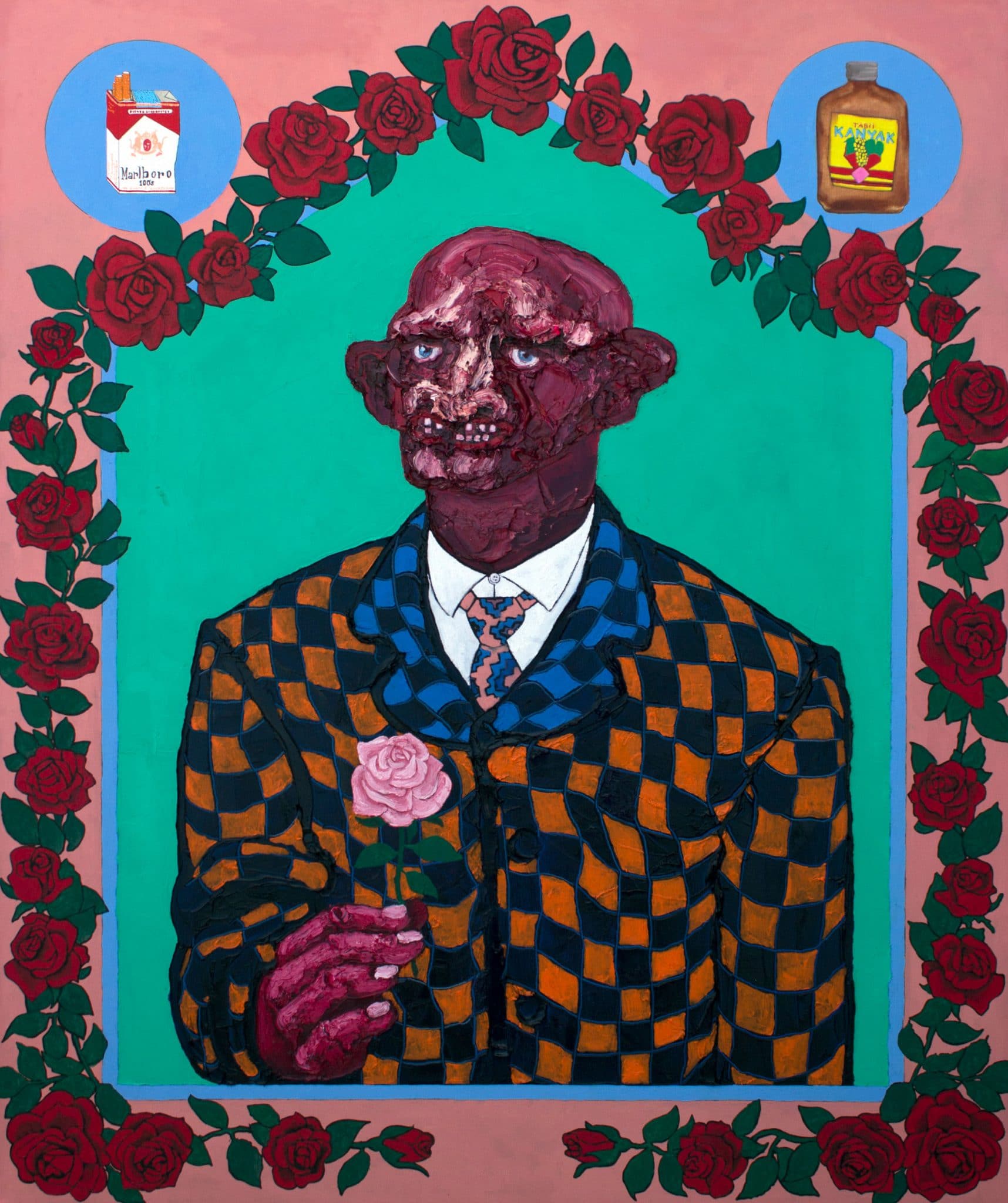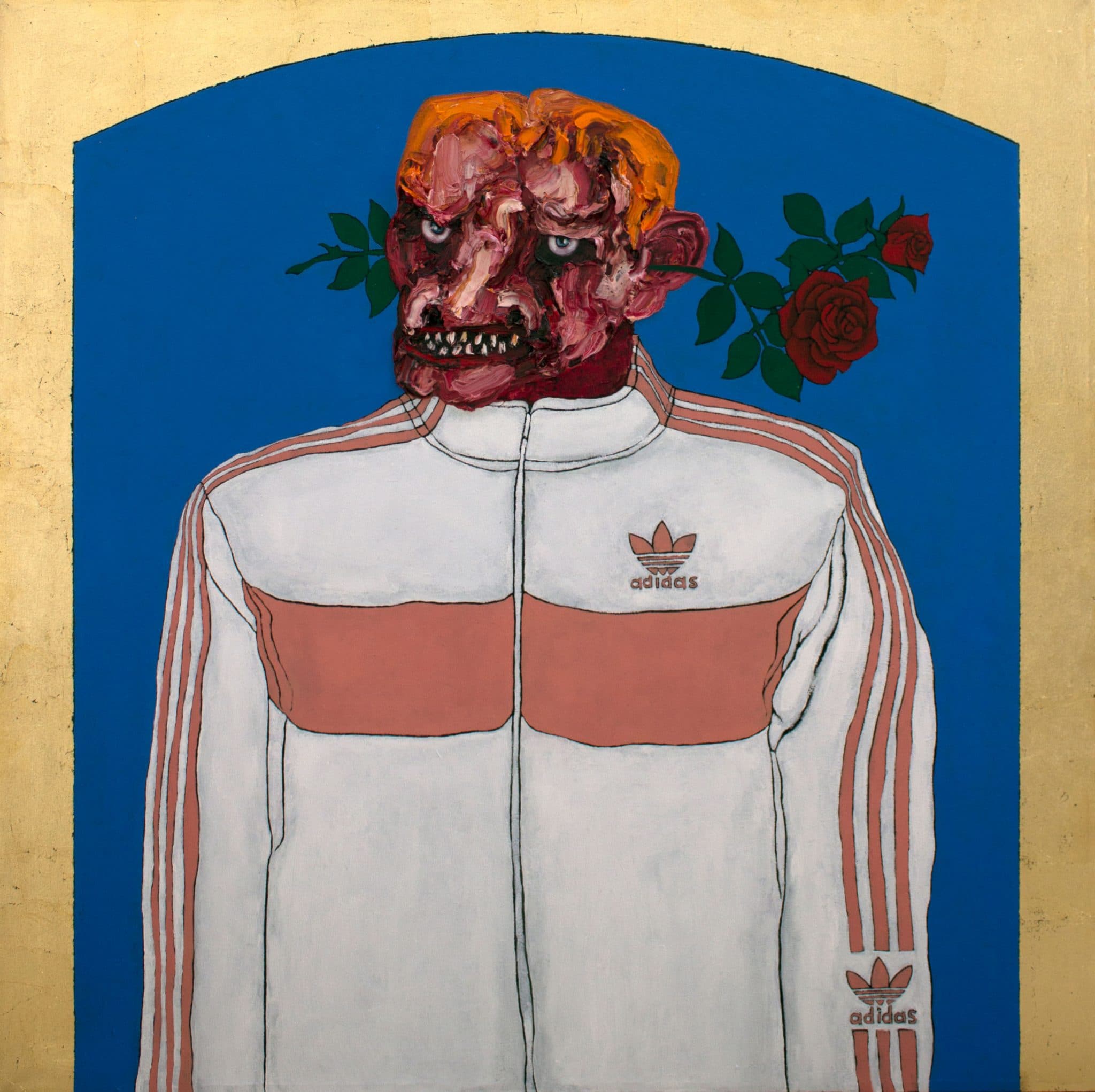How do you feel during this time of lockdown; how do you think this period will affect your art-making process or does it already have an impact on your productions?
In short, I can say that I came to value the state of being free. Frankly, I do not want this period to be reflected in my work. I prefer to stay normal or at least act as if things were normal. Otherwise, I think the next step will result in a great loss and disconnection for me. I try to prevent this from happening. To eliminate the desire to go out, I produce by night and spend the day by sleeping. However, I don’t know how long I can keep up with this.
Do you keep producing works during this time? If yes, how do you produce under the changing conditions, do the materials you use differ?
There is a small space at home, that I reserved for work, so I can continue producing. However, I cannot produce works as free or at least in large scale as I would in my atelier. I can say that I amuse myself with canvas and small paper works.
What are you dreaming of doing following COVID-19?
At the moment, I only dream of this period being over 😊.
Are there any differences between your plans before and after COVID-19?
Since we are talking about creating artwork, I will answer this question in the same context. Apart from exceptional circumstances, I am not an artist who produces according to an exhibition schedule. In other words, I have never experienced something like: I have an exhibition coming up – now I have to produce something. Frankly, I never needed this because I was producing continuously anyway. I produce project-based serial works and when I reach the necessary amount to exhibit, I exhibit. My gallery mostly plans this. There were events planned by my gallery before the virus that I was involved in. Fairs such as Art Dubai and Art Paris have been canceled. There is the Draw Art Fair London in May, but I think it will also be canceled. Apart from these, there were several exhibitions and fairs in Turkey, which have all been canceled due to the circumstanced we are currently in. I’m sure that there will be new events and exhibitions after this is over, but I’m not involved in the planning of these. In the meantime, I will continue to produce just like before. That’s the only thing I know.
What changes occurred in your daily routine?
As I mentioned before, day and night changed places. I produce at night; I sleep during the day.
As an artist, how would you describe the current situation of the world?
I can’t comment because there are questions I can’t find the answer to. It amazes me that the world in the 21st century is so powerless against a virus. Have almost all of the technological developments we have seen so far been used only for flashy consumption purposes? I guess this is the most important question that people are looking for an answer to.
Has the current isolation given you the opportunity to do or create something that you haven’t had a chance before?
With regards to producing, I have never had a problem such as lack of time. Hence, there is no gain in this context that can be attributed to this period of isolation.
Unfortunately, your works cannot be seen physically in this period of time. Can you tell us about your new works conceptually?
Ever since I’ve been locked up at home, I’ve been working on pieces related to the concept of identity. The concept of identity can be briefly defined as the conscious perception of a person or community about their qualities, status and values. Individual identity is usually formed in a hierarchical order within a complex social structure that includes other personal and collective identities. Similarly, social identity occurs as a result of the interaction of many different identities.
According to John Turner (1978), “an individual’s self-concept and therefore self-esteem is anchored in the social class he belongs to, that is, the social identity he perceives.” The social identity built on similarities with other people is very closely related to the individual and serves him in several ways. Identity conflicts such as recognition, approval and support by a group are not limited to individual and social identities. For example, in the historical dimension, a differentiation can be observed between the traditional society, the modern society, and today in terms of problems and understanding of identity. Another identity-related conflict dimension is between the given identities we are born with and the acquired identities that are consciously acquired in the process of self-development and socialization. Again, another axis of conflict, which concerns the identity process, arises between the public and private spheres.
All of this create one of the most intense tension lines as a result of the clash of many identities that surround the individual’s self. The individual often has many identities competing and clashing with each other at the same time. Roughly, an individual, that we assume to be an artist, takes on a different identity when he is with his family in the place where he was born and raised. Whereas the identity he has in the setting of the gallery he works with or next to a collector is something else. Or, while an academic exists with a certain identity in any given location, the identity he tries to convey when giving lectures in a lecture hall is completely different. The Abdul-cambaz series came about when I discovered this type of behavior that develops within the framework of interpersonal relationships that I saw in myself and my environment.
This can be considered as an individual questioning. Or a mischievous criticism of the different types of behavior mentioned. Since this questioning, criticism, or confrontation with myself will be performed by my second or third identities, I thought it would be wise to treat the imaginary character created as a real individual. So, a new language had to be created that was part of me, but then again, did not belong to me. This was the language of Abdulcambaz. In order to create this language, I started this series by practicing methods that I never thought I would use before.
Karantina döneminde nasıl hissediyorsunuz; bu süreç üretimlerinize nasıl yansıdı ya da yansıyacak?
Kısaca özgür olmanın değerini fazlasıyla anladım diyebilirim. Açıkçası sürecin işlerime yansımasını istemiyorum. Normal kalmak ya da en azından normalmiş gibi davranmak işime geliyor. Aksi halde benim için bir sonraki aşama büyük bir kayıp ve kopuklukla sonuçlanacaktır diye düşünüyorum. Öyle olmaması için direniyorum. En azından sokağa çıkma isteğini ortadan kaldırabilmek adına gece sabaha kadar üretip gündüzleri uyuyarak geçiriyorum. Ancak bunu ne kadar daha sürdürebilirim bilmiyorum.
Bu süreçte üretmeye devam ediyor musunuz? Evet ise değişen şartlar altında üretim şekliniz, kullandığınız malzemeler farklılık gösteriyor mu?
Evimde üretim için ayırdığım küçük bir alan vardı. Dolayısıyla üretime devam edebiliyorum. Ancak atölyemdeki kadar özgür ya da en azından istediğim ölçekte işler üretemiyorum. Tuval ve ufak tefek kâğıt işleriyle kendimi avutuyorum diyebilirim.
Bu süreç bitimindeki hayalleriniz neler?
Şu an sürecin bitmesi dışında bir hayalim yok 😉
COVID-19 öncesindeki planlarınız ile sonrası arasında farklılık var mı?
Özellikle üretim bazlı konuştuğumuz için bu soruyu da aynı bağlamda yanıtlayacağım. İstisnai durumlar dışında bir sergi planına sadık kalarak üretim yapan bir sanatçı değilim. Yani şu tarihte sergim var, hadi yeni iş çıkarmam lazım gibi bir şey hiçbir zaman yaşamadım. Sürekli üretim halinde olduğum için buna ihtiyacım da olmadı açıkçası. Proje bazlı seri işler üretiyorum ve sergilemek için yeterli ölçeğe ulaştığım zaman sergiliyorum. Bunun planlamasını çoğunlukla galerim yapıyor. Virüsten önce galerim tarafından planlanmış ve benim de dahil olduğum etkinlikler vardı. Örneğin; Art Dubai, Art Paris gibi fuarlar iptal edildi. Mayıs’ta Draw Art Fair London var, ancak sanırım o da iptal edilir. Bunların dışında Türkiye içinde birkaç sergi ve fuar vardı, içinde bulunduğumuz bu süreç hepsinin iptal olmasına neden oldu. Bu süreç atlatıldıktan sonra sanırım yeni etkinlik ve sergiler olacaktır, ancak bu planlamalar benim dışımda gelişiyor. Ben öncesinde nasıl üretiyorsam sonrasında da aynı şekilde devam edeceğim. Bildiğim tek şey bu.
Günlük rutinlerinizde ne gibi değişiklikler oldu?
Yukarıda da bahsettiğim gibi geceyle gündüzüm yer değiştirdi. Gece üretiyorum gündüz uyuyorum.
Sanatçı gözünden dünyanın içinde bulunduğu durumu nasıl yorumlarsınız?
Yorumlayamıyorum çünkü cevabını bulamadığım sorular var. 21. yüzyıl dünyasının bir virüs karşısında bu denli aciz kalması beni şaşırtıyor. Bugüne kadar gördüğümüz teknolojik gelişmelerin hemen hepsi sadece gösterişçi tüketim için mi kullanılmış? Sanırım çoğu insanın cevabını aradığı en önemli soru bu.
Sosyal izolasyon süreci, size yapmak istediğiniz ama zamansızlıktan dolayı yapamadığınız bir iş, üretim için zaman sağladı mı?
Üretimle ilgili bir zamansızlık sorunum hiç olmadı. Dolayısıyla sürecin bu bağlamda bana kazandırdığı bir durum söz konusu değil.
Bu süreçte eserleriniz maalesef somut olarak görülemeyecek, bu nedenle çalışmalarınızdan kavramsal ve biçimsel olarak bahsedebilir misiniz?
Eve kapandığımdan beri üstünde çalıştığım işler kimlik kavramı ile alakalı. Kimlik kavramı kısaca, bir kişi ya da topluluğun kendi nitelikleri, konumu ve değeri hakkındaki bilinçli algılaması olarak tanımlanabilir. Bireysel kimlik genellikle hiyerarşik bir düzende başka kişisel ve kolektif kimlikleri de kapsayan karmaşık bir toplumsal yapı içerisinde oluşur. Benzer bir şekilde, sosyal kimlik de pek çok farklı kimliğin etkileşimi sonucunda meydana gelir.
John Turner’a göre (1978), “bir bireyin benlik kavramı ve dolayısıyla da benlik saygısı, onun sosyal sınıf üyeliğine, yani algıladığı sosyal kimliğine demirlenmiştir” Başka insanlarla olan benzerlikler üzerine kurulan sosyal kimlik, bireyi çok yakından ilgilendirir ve çeşitli yönlerden ona hizmet eder: bir grup tarafından tanınma, onaylanma, desteklenme gibi kimlik bağlamındaki çatışmalar yalnızca bireysel ve sosyal kimliklerle sınırlı değildir. Örneğin, tarihsel boyutta, geleneksel toplumun, modern toplumun ve günümüzün kimlik anlayışları ve sorunları arasında da bir farklılaşma gözlenebilir. Kimlikle ilgili bir başka çatışma boyutu, içine doğduğumuz verili kimliklerle benliğin gelişmesi ve sosyalleşmesi sürecinde bilinçli olarak edinilen kazanılmış̧ kimlikler arasında yaşanır. Yine, kimlik sürecini yakından ilgilendiren diğer bir çatışma ekseni, kamusal alanla özel alan arasında ortaya çıkmaktadır.
Tüm bunların hepsi bireyin benliğini saran çok sayıda kimliğin birbiriyle çatışması sonucu en yoğun gerilim hatlarından birini oluşturur. Birey çoğu zaman birbiriyle yarışan ve çatışan birçok kimliğe aynı anda sahiptir. Kabaca örneklendirecek olursak sanatçı olduğunu varsaydığımız bir birey ailesinin yanında ve doğup büyüdüğü bölgede başka bir kimliğe bürünürken, çalıştığı galeri ortamında veyahut bir koleksiyonerin yanındayken büründüğü kimlik bir başkadır. Ya da bir akademisyen herhangi bir makamda farklı bir kimlikte var olurken, bir amfide ders verirken var olmaya çalıştığı kimlik başkadır. Abdul-cambaz serisi kendimde ve çevremde gördüğüm kişiler arası ilişkiler çerçevesinde gelişen bu tip davranış biçimlerini keşfetmemle ortaya çıktı.
Bu bireysel bir sorgulama olarak kabul edilebilir. Ya da bahsedilen farklı davranış biçimlerine yaptığım muzipçe bir eleştiri. Bu sorgulama, eleştiri ya da kendimle yüzleşme durumu ikinci ve üçüncü… kimlikler üzerinden olacağı için yaratılan hayali karaktere gerçek bir bireymiş gibi davranmanın akıllıca olacağını düşündüm. Dolayısıyla benim bir parçam olan, ancak bana ait olmayan yeni bir dil oluşturulması gerekiyordu ve bu Abdulcambaz’ın dili olacaktı. Bu dili yaratmak için de şu ana kadar hiç yapmadığım ve asla yapmam dediğim pratikleri deneyimleyerek bu seriye başladım.




